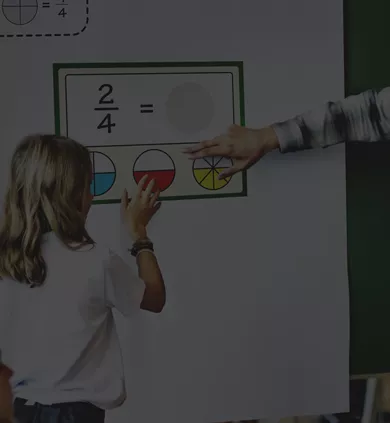-
- Curriculum content & assessment
- Overview
- Key Stage 3
- GCSE
- GCSE resits
- Functional skills
- Nationals
- International
- Pricing
- Customer stories
-
- Why Access Education?
- About Access Education
- Guides & webinars
- Meet our experts
- Blogs
Access KS3 Maths Curriculum: Building confidence for Key Stage 4 success
Access KS3's Maths Curriculum: The ultimate tool designed to instill confidence in all aspects of mathematics and lay a robust foundation for success in Key Stage 4. Our curriculum utilises carefully crafted videos and infographics to simplify complex methods, making problem-solving clear and straightforward.
Through frequent knowledge checks and formative assessments, students have lots of opportunities to put their learning into practice, embedding knowledge and boosting their confidence.
And, as teachers, it makes your job a whole lot easier, too!

Unlock the power of maths
We aim to make maths an enjoyable and memorable learning experience. We stress real-world applications, helping students understand the practical relevance of mathematics in their lives. This approach fosters a deeper understanding and more informed responses.
Access KS3's Maths Curriculum is your trusted partner in nurturing confident, critical-thinking students ready for success in mathematics and beyond.
Why choose our KS3 Maths curriculum?

Meet national curriculum aims
Aligned with the National Curriculum's objectives, covering Number, Algebra, Geometry, and Data in logical stages. Your students will begin with core knowledge and methods, gradually progressing to more advanced concepts and calculations.
This step-by-step approach ensures that they build a strong understanding of the foundational concepts before tackling more complex mathematical topics.

Clear and engaging instructions
Our carefully crafted resources, including videos and infographics, are designed to make even the most intricate historical concepts accessible to all learners. These resources break down complex ideas into a series of digestible, easy-to-follow steps.
By combining visual and auditory elements, we create an engaging experience that keeps students captivated and motivated.

Interactive learning and self-paced progress
Our KS3 Maths Curriculum embraces interactive learning, allowing students to actively engage with mathematical concepts at their own pace. Students have the freedom to explore the material in a way that suits their individual learning style, ensuring they feel in control of their mathematical journey.
Through a range of interactive activities, quizzes, and self-assessment tools, students can monitor their progress, identify areas of strength, and pinpoint where additional focus may be required.
Find out how you can help your students on their journey to GCSE success
Key features of Access KS3 Maths Curriculum
Frequent knowledge checks
Within our KS3 Maths Curriculum, we place a strong emphasis on continuous assessment through frequent knowledge checks and formative assessments. These assessments are strategically integrated into the learning journey and serve several essential functions:
- Progress monitoring
- Learning reinforcement
- Adaptive learning
- Confidence building
- Summative assessment preparation
- Enhanced retention
Incorporating frequent knowledge checks and formative assessments into our curriculum is not only about evaluating students but also about nurturing their growth as mathematicians.

Mastery tasks for challenge
Recognising that not all students progress at the same pace, our KS3 Maths Curriculum caters to the needs of higher-ability students by offering a dedicated feature: Mastery Tasks. These tasks are designed to challenge and engage those seeking additional depth and complexity in their mathematical exploration.
Key attributes of our mastery tasks:
- Higher cognitive demands
- Promoting independence
- Deeper mathematical understanding
- Preparation for advanced studies
- Encouraging curiosity
- Holistic skill development
The inclusion of mastery tasks ensures that higher-ability students have the opportunity to stretch their mathematical capabilities to their fullest potential.

Summative assessments for reinforcement
Towards the end of each unit, our curriculum offers a valuable resource: summative assessments. These assessments play a pivotal role in consolidating and reinforcing the learning that students have acquired throughout the term.
They are not just evaluations; they are instruments for achieving comprehensive mastery of mathematical concepts and preparing students for future success in mathematics and real-world scenarios.

Y7 transition assessments
In our KS3 Maths Curriculum, we recognise the profound impact that achievement at this stage has on a student's performance across all subjects, especially in their future GCSE examinations. Therefore, our primary objective is to assist you in laying a strong foundation for literacy and numeracy skills right from Year 7.
Our Transition Assessments are tailored to the content of the KS3 Maths Curriculum, mirroring the essential components taught in Year 6 and providing Year 7 teachers with an accurate and up-to-date assessment of their students' mathematical abilities.
What's in Access Key Stage 3 Maths curriculum?
Year 7
7.1 Number
- Written methods for addition and subtraction
- Written methods for multiplication and division
- Time
- Ordering integers and decimals
- Adding and subtracting negative numbers
- Multiplying and dividing negative numbers
- Multiplying and dividing by powers of 10
- Adding and subtracting with decimals
- Multiplying and dividing decimals by integers
- Money problems
- Rounding numbers to a given degree of accuracy
- Estimate answers to spot mistakes/check for reasonableness
7.2 Algebra and geometry
- Use correct Order of Operations in calculations
- Use function machines to create inputs and outputs
- Recognise, describe and write down sequences based on a simple rule
- Find missing terms in patterns and sequences
- Square,cube, triangles numbers
“Proper” algebra e.g. language of and substituting - Collecting like terms
- Recognise and use appropriate metric units
- Accurately measure and draw straight lines
- Perimeter of any 2D shape
- Area of squares, rectangles and shapes made from them
- Volume of cubes and cuboids
7.3 Number and data
- Factors, multiples, primes, HCF, LCM
- Equivalent, simplifying and comparing fractions
- Improper and mixed fractions
- Addition and subtraction of fractions
- Fraction of amount
- Writing percentages
- Converting between fractions, decimals, and percentages
- Averages and range
- Collecting data
- Charts
- Probability (language and scales)
- Simple probability (equally likely)
Year 8
8.1 Algebra
- Multiplying and dividing algebraic expressions
- Expanding single brackets
- Factorising expressions
- Substitution
- Solving linear equations
- Solve equations with brackets
- Generating sequences from rules and nth terms
- Finding the nth term of an arithmetic sequence
- Coordinates
- Graphs of horizontal and vertical lines
- Completing coordinate tables for straight line graphs
- Drawing straight line graphs
8.2 Number and geometry
- Estimation
- Multiplying with decimals
- Dividing with decimals
- Multiplying and dividing with fractions
- Translations
- Rotation
- Area of parallelograms and trapeziums
- Angles in parallel lines
- Interior and exterior angles
- Properties of 3D shapes
- Surface area of cubes and cuboids
- Volume of cubes and cuboids
8.3 Number and data
- Percentages of amounts
- Percentage change
- Simple interest
- Writing and simplifying ratios
- Calculating with ratios
- Best buys
- Powers and roots
- Venn diagrams
- Prime factors
- HCM and LCM
- Averages from grouped data
- Experimental probability (include expected frequency)
Year 9
9.1 Number and algebra
- Writing numbers in standard form
- Calculations with standard form
- Laws of indices
- Compound interest
- Writing expressions and formulae
- Solving linear inequalities
- Changing the subject
- Changing the subject
- Solve equations with unknown on both sides
- Expanding double brackets
- Problem solving with FDP
- Working with exchange rates
9.2 Geometry
- Nets and surface area
- Similar and congruent shapes
- Enlargement
- Circles
- Volume
- Converting units of area and volume
- Pythagoras’ Theorem Part 1
- Pythagoras’ Theorem Part 2
- Plans and elevations
- Constructions and bisectors
- Loci
9.3 Graphs and data
- Direct proportion
- Inverse proportion
- Calculating gradients
- y = mx + c
- Drawing quadratic graphs
- Real life graphs
- Speed distance time
- Distance time graphs
- Sample space diagrams
- Two way tables
- Tree diagrams
- Scatter graphs

